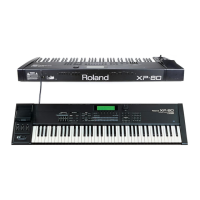40
Turning effects on/off
Built-in effects units (EFX, Chorus and Reverb) can be
turned on/off for the XP-80 as a whole. Turn them off if you
want to edit sound while listening to the original sound or if
you want to use external effects units.
<Procedure>
❶ Press [EFX], [CHORUS] and [REVERB] to switch each
on (indicator lights) or off (indicator off).
On the Play display of each sound source, EFX, CHO, and
REV are respectively indicated at right when switched on.
✳ If [EFX], [CHORUS] and/or [REVERB] are OFF, para-
meter settings will have no effect. On the General dis-
play (PATCH/Effects), (PERFORM/Effects) or
(RHYTHM/Effects), effects which are turned off will
be indicated with a gray box.
❚
Sound editing procedures
With the XP-80, you have total control over various settings.
Each item to be set is a parameter. Editing refers to modify-
ing any parameter value. This section goes over editing pro-
cedures for Patches, Performances and Rhythm Sets.
Editing a Patch
Start by editing a preexisting Patch to create a new one. Since
a Patch is a combination of up to any four Tones, you should
listen to how the individual Tones sound before you edit.
...........................................................................................................
<Four tips for editing Patches>
Start with a Patch that’s somewhat familiar sounding
It’s hard to create a new sound that’s exactly what you want
if you just select a Patch and modify its parameters at ran-
dom. It makes sense to start with a Patch whose sound is
related to what you have in mind.
Deciding on the Tone to use
When creating a Patch, deciding on the Tones you’ll use is
crucial. For each Tone, use the TONE SWITCH [1]–[4]
(BANK [1]–[4]) to decide whether to turn it on (have it
sound) or off. Turn off Tones you don’t need to avoid using
more voices than required. A Tone switches on/off each
time its respective button is pressed. When a Tone’s indica-
tor lights, it’ll sound.
Check the Structure setting
The important Structure Type parameter (PATCH/
Common/Structure) determines how the four Tones com-
bine. Before editing Tones, make sure you really understand
how they work together.
Turn off effects
Since XP-80 effects really influence the sound, turn them off
to listen to the sound itself so you can better evaluate the
changes you’re making. Sometimes just changing effects set-
tings can give you the sound you want.
...........................................................................................................
<Procedure>
❶ In the Play display (PATCH), press a button from [F1]
(Common)–[F6] (Effects) to choose the display group
you want.
❷ Press a button from [F1]–[F6] to call up the desired dis-
play page.
❸ If you have selected any of [F2] (WG)–[F6] (Effects) in
step 1, press TONE SELECT [1]–[4] (BANK [5]–[8]) to
choose the Tone you wish to modify. The button indi-
cator of the selected Tone will light and the Tone num-
ber will appear at the display upper right.

